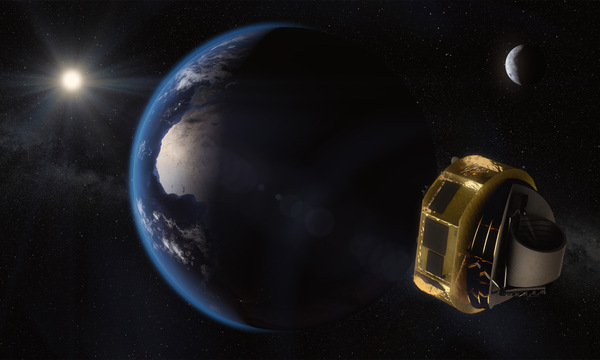ELSI Viewpoint
ELSI Researchers comment on Science in the News (No. 1)
ELSI researchers talk about the new exoplanet mission from the European Space Agency
The European Space Agency (ESA) selected their fourth medium-class science mission to be launched in 2028.
Image credit: ESA
The mission is known as "ARIEL", standing for the "Atmospheric Remote-sensing Infrared Exoplanet Large-Survey mission". It is a space telescope dedicated to exploring the atmospheres of exoplanets; planets that orbit stars beyond our own Sun.
ARIEL can explore the atmosphere of exoplanets in three different ways. The first technique detects the starlight filtering through the atmosphere of exoplanets as the planet passes (or "transits") in front of the star. Molecules in the planet atmosphere absorb different wavelengths of the light, producing a fingerprint of missing light bands that tell astronomers what gases may be in the atmosphere. This technique is known as "transmission spectroscopy". ARIEL can also look at the light coming from the planet itself. In this second technique, ARIEL examines the light as the planet circles behind the star on its orbit. Just before the planet vanishes behind the star, ARIEL will see the combined luminosity from both the star and the planet before they eclipse one another again. Comparing this to when only the star is visible allows ARIEL to analyse the wavelengths of light reflected and emitted by the planet. This is called "eclipse spectroscopy". Finally, ARIEL can examine three dimensional variations in the planet atmosphere by looking at how the planet's luminosity changes as different parts of the planet come into view during its orbit. These are known as "phase variations".
Associate Professor Yuka Fujii and Affiliated Scientist Elizabeth Tasker here at the Earth Life Science Institute (ELSI) were asked by "Nature" to comment on why this mission is so exciting to exoplanet researchers.
Exoplanet studies are already a big focus in Japan. The Subaru telescope in Hawaii and the Okayama Astrophysical Observatory have conducted dedicated surveys to search for exoplanets, and Japan is also part of the up-coming Thirty Metre Telescope (TMT) which has exoplanets as one of its major science goals.
At ELSI, the prospect of detecting exoplanet atmospheres is particularly exciting. As Fujii and Tasker highlight below, the composition of the gases surrounding the planet can reveal details about its formation and any geological processes that may be occurring. The focus of ELSI is how such planetary processes operate and potentially give rise to the beginning of life, so the prospect of data from systems beyond our Sun is incredible exciting. Giovanna Tinetti, a planetary scientist at University College London in the UK and the principal investigator for ARIEL has previously visited ELSI to discuss atmospheric spectroscopy and the connection with the research done within our institute. Speaking to "Nature", Tinetti describes ARIEL saying, "ARIEL can really give us a full picture of what exoplanets are made of, how they form and how they evolve."
The Nature article can be found here while a longer transcript of the interview with Fujii and Tasker is below.
Given the number of exoplanet missions already planned or in existence, where does ARIEL fit into exoplanet studies?
Tasker:
In my mind, exoplanet observations are separated into two different types.
The first are telescopes that tell us about exoplanet statistics. These missions reveal information about the number of planets around other stars, their orbits and average sizes.
 Dr. Elizabeth Tasker (Photo credit: Nerissa Escanlar)
Dr. Elizabeth Tasker (Photo credit: Nerissa Escanlar)
The Kepler Space Telescope, the La Silla telescope in Chile, the Okayama Planet Search Program, the microlensing (brightening of background starlight due to bending by a planet's gravity) serches MOA and OGLE, and upcoming space missions such as TESS, Plato and CHEOPS are all examples of instruments doing this kind of survey. The results so far have been amazing: these telescopes have taught us planet formation is common, even around stars far different from our own Sun. That planets have a myriad of sizes and orbits, most of which have no analogue in our own Solar System. They have shown us our own system of planets around the Sun is far from alone.
However, this type of mission cannot tell us what individual planets are really like: the amount of information per planet is scarce and limited to bulk size and how much radiation (starlight) the planet receives. So this doesn't translate to what conditions are like on the surface and provides only a few clues about the planet's formation.
The second type of observations are from missions like ARIEL. ARIEL will be the first telescope completely dedicated to probing the atmospheres of exoplanets. The composition of this cloak of gases is related to how the planet formed and (for rocky worlds) what processes may be happening on the surface. In short, the planets go from 'shadows' (a term I heard Dr Aki Roberge use from NASA Goddard Space Flight Center) where we detect them due to their influence on stars, to real systems like our own planet, the processes of which are the main focus of ELSI.
Fujii:
Spectroscopic observations of the atmospheres of transiting planets have opened a new avenue to characterise exoplanets and obtain insight into their formation and evolution. Currently, such atmospheric data has been obtained for a relatively small number of planets using the Hubble Space Telescope and the Spitzer Space Telescope, as well as ground-based telescopes. The new large space observatory, the James Webb Space Telescope (JWST) will be launched in 2019 and is expected to play a critical role in atmospheric characterisation of transiting exoplanets. In 2020s, the next generation ground-based telescopes will have first light and will be used for exoplanets. These include the Thirty Metre Telescope (TMT) which Japan is involved in.
 Dr. Yuka Fujii (Photo credit: Nerissa Escanlar)
Dr. Yuka Fujii (Photo credit: Nerissa Escanlar)
A complementary technique is also employed by existing largest ground-based telescopes including Japan's Subaru telescope, which looks at the light coming directly from planets that are luminous enough and sufficiently distant from the bright star to detect. JWST and the next-generation ground-based telescopes will also employ this technique to further investigate planetary atmospheres.
However, all of these observatories are general, multi-purpose observatories. The observation time allocated for exoplanets is limited, and the instruments are not necessarily specialised for exoplanet observations. For example, multiple transits (orbits in front of the star) are needed to cover the broad spectral range (looking at each different wavelengths of light) with JWST.
On the other hand, ARIEL is a dedicated mission for exoplanets, and will survey approximately 1000 planets. Given the wide diversity of planetary systems, it is critical to obtain this large number of samples to be able to formulate a unified view on their atmospheres and their relation to formation and evolution pathways.
With the current datasets, we have unsettled questions including why some planets have flatter spectrum (less evidence of light being absorbed by different molecules) and others with distinct absorption features, and the diversity of atmospheric inventories and profiles is not well understood. The large number of planets ARIEL will give us more clues. I am excited by these possibilities for ARIEL!
Will ARIEL influence how we think about 'habitability' of exoplanets?
Tasker:
One of the biggest discoveries I feel our current exoplanet instruments have told us is that planets really move: as in, their orbits change and they migrate away from their birth location. We know this because we see large planets (super Earths and Jupiter-sized giants) close to the star and there's no obvious way for them to form there: there just isn't enough building material so close to the stellar inferno. But this leads to an important conclusion: just because a planet is Earth-sized and receives a similar amount of radiation from the star as we do from the Sun (putting the planet in the so-called "Habitable Zone"), there's no guarantee that world will be Earth like.
A good example of this is the TRAPPIST-1 worlds, which are unusual in having both radius and mass measurements giving them an estimated bulk density. These planets have densities lying between gas worlds like Neptune and rocky worlds like Earth, suggesting they may be heavy in water. That, combined with their unusual resonant orbital configuration, suggests they have have formed further from the star and moved inwards. But can a planet with a surface that resembles a gas giant's core have geological processes (e.g. a carbon silicate cycle or a magnetic field) that supports life on Earth?
One of ARIEL's main targets is hot planets that are close to their star. Now these are too warm to be habitable themselves, but they also may well have migrated inwards from colder and more distant parts. By examining their atmosphere, we hope we may get clues to their birth location and the evolution of the planetary system. This can give hints at what migrated worlds may be made from, their geological processes and on delivery of the key ingredients for life, such as how water moves around a planetary system (e.g. in our own system, we think the Earth may have formed dry but later bombarded by icy meteorites like those that currently come in as comets or asteroids).
Fujii:
To planetary scientists, habitability is not the only important thing. We want to know what's out there.
Temperate Earth-sized planets are near the limit of what ARIEL will be able to detect. The main impact of ARIEL for understanding habitable worlds may be more indirect. By understanding the nature of larger, warmer planets with ARIEL, we will learn about their formation and evolution, and the connection with various properties such as size and orbit, the star type, and the system architecture.
This will ultimately have implications for potentially habitable planets in a given system, as a planet's current surface environment depends critically on how it formed and evolved. "Earth-sized planets in the habitable zone" are not necessarily habitable! For example, whether a planet experiences significant orbital migration which causes it to move from its formation location, what kind of materials made the planet and how the radiation from the star changed over time all affect the present habitability of a given planet. Clues to these may be obtained by characterising a large number of the bigger, hotter planets that will be targeted by ARIEL. In addition, data from ARIEL will allow developments in analysis of exoplanet observations and this will benefit the future characterisation of smaller, cooler planets.













